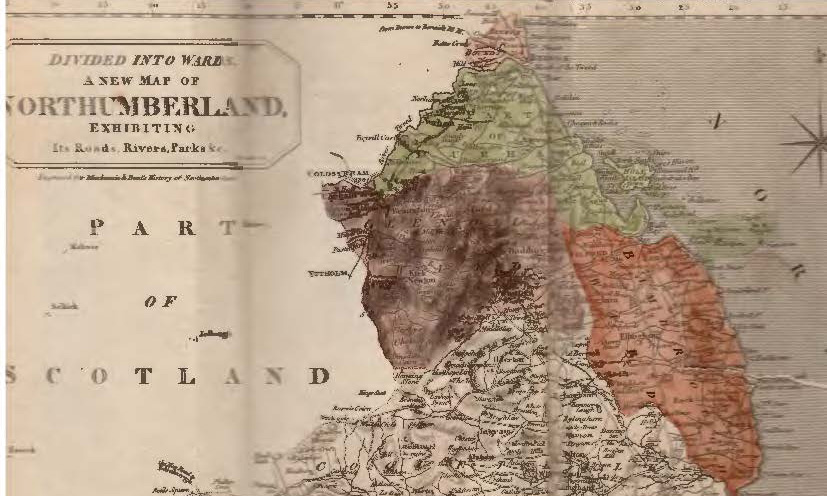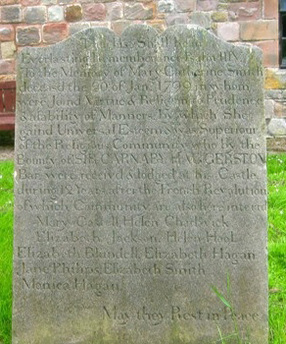|
Generally speaking we all enter the world in the same way, head first! We are all born in different circumstances this is true, but always with a minimum of two people present. How we depart, however, is a very different story. My Grandmother had a saying that it was a waste to go through life without ‘leaving evidence of your passage’, which I believe may have been an adaptation of a famous quote by Pope John XXIII. Certainly, during the years I have spent researching family history, I have encountered many different dispatches, some tragic, some inexplicable and some downright bizarre. If you follow my blogs you may have encountered a few already. Who can forget the ‘melancholy accident’ of the 31st December 1822, when Aaron Young was drowned in the River Whiteadder, or the fate of poor Miss Donkin, struck by lightning on the eve of her marriage in July 1837? Of course we are nearly all guilty of ‘presentism’; that is scrutinising past events through 21st Century eyes. For example, Mr Young had to have partaken of ‘one too many’ given the date of his demise right? Not necessarily – take a bit of time to reflect alternative routes from where he was travelling from – Fairlaw, in Berwickshire, and where he was headed – Loanend, near Norham on the south side of the River Tweed. Now try and plot a course for a horse and cart in 1822… Before heading off to examine what can be learned about people and places from death and burial records here are a few more that have not made blog headlines thus far: Robert Nicholson, fell foul of, and was ‘presumed consumed by natives’ circa 1792 in the Pellew Islands. He was the husband of Jacobina Nicholson (his cousin), famed for passing notes to her brother in the toes of stockings. The wedding party that was called off at the last minute circa 1870 as the fiancé of Jane (Jennie) Nicholson, daughter of George Kerr Nicholson, (3 times Mayor of Berwick), committed suicide at the Kings Head Berwick ‘much to the consternation and dismay of the assembled guests at Norham’. Richard Robson, of Greenhill, near Bamburgh was killed at Lucker station 16th February 1850, crossing in front of a train. And most bizarrely of all, a descendant of the Taylor family, one Mr Robert Taylor a plasterer and slater was killed at Ord Hill on 26th June 1912 ‘by a hen running into his bicycle’. These aside, as many folks who are endeavouring to uncover their ancestral roots in the ‘Borders’ will know, they are faced with more challenges than most. A high instance of ‘non conformity’ or ‘religious dissention’ combined with loopholes in the marriage laws in Scotland are compounded by the differences in cross border statutory regulations regarding the registration of Births Marriages and Deaths. This extract from the 1821 Statistical accounts for Northumberland illustrate just how many births may have slipped under the radar. Whilst statutory registration became law in England and Wales in 1837, Scotland did not follow suit until 1855. Records of deaths in Scotland before this time can be most ‘haphazard’, with the hire of the parish morthcloth in the Kirk Session records possibly the only record that it took place at all. When searching for Scottish burials it is worth remembering the married women often appear under their maiden names, and folks were often buried in their native parish, rather than the parish where they died. Conversely, Scotland may have been slower on the uptake, but their records post 1855 more than make up for this. The information that can typically be found is illustrated in this table taken from ‘Scotland’s People’: A word of warning. As with any record, the information they contain is only as accurate as the evidence presented at the time. Whilst current, or events of the recent past are more likely to be correct, details of parents names etc., may not be quite so reliable. I have found this to be the case where the individual’s parents died young and were perhaps not known to the informant. I have also had cases where name of a grandparent or other relative that has been entered instead. If other siblings to the deceased are known, it may be a useful exercise to compare the information contained in their records too. In England often the most overlooked records that remain in the pre statutory registration period (1837) are also the burial registers. These records have often not been indexed or digitised, not or they readily available online. However, in the absence of non- Anglican cemeteries and before cremation was legalised in 1884, many Christian denominations were interred in the local parish churchyard. Various pieces of legislation were passed in the 16th Century requiring the recording of birth marriages and deaths in a parish register. However these largely depended on the reliability of the parish priest and churchwardens. Information can be very sparse, with only the essentials listed, and vary enormously from parish to parish. An order in 1598 required each parish to send a copy of all the baptisms, marriages and burials which had taken place in the previous year to the Bishop of their Diocese within one month of Easter. These are known as Bishop’s Transcripts and can be a useful source of information if the original registers have not survived. Some of these transcripts are available online at 'Family Search' However searching them can be a laborious process as they are neither transcribed nor indexed. ‘Rose’s Act’ of 1812 came into effect in early 1813 and standardised the information that was to be recorded in pre-printed BMD registers. For burials this was:
Another peculiarity of the Border region that often traps unwary researchers is that the northern part of Northumberland encompassing the parishes within the Ward of ‘Norham and Islandshire’ was actually part of Durham. See map below from an 1811 History of Northumberland, kindly coloured green by one of my own forebears! and a rather more legible version form 1852 In 1798, Bishop Barrington of the Diocese of Durham required all his clergy to enter more information in their baptism and burial registers. This is of particular benefit to researchers looking for records of ancestors in the parishes of North Northumberland which fell under this new ruling. From this date birth and burials often contain the following:
Example from the Baptism register for Ancroft, 29th January 1800: Thomas Straker, 3rd son of John Straker of Ancroft Mains, Farmer, native of Long Framlington in the County of Northumberland by his wife Frances widow of Robt. Glendinning, Salmon Cooper, Berwick upon Tweed and daur of Wm. Taylor formerly of Lowick in Coun. Dur. Born Jan. 22, Bap. 29th Anno 1800. And the Burial Register for Cornhill on Tweed for April 30th 1798: Isabella Davidson of the Roads, parish of Ford, House-Keeper, dau. of Richard Davidson, Husbandman by his wife Isabella, late Runcheman. Died April 28. Age 42 yrs. Consumption. Where the cause of death, occupation and native parish information is recorded a great deal can be learned about the parish itself. From these it is possible to track:
Many of the burials recorded are for the very young, or the very old, with a higher death rate during the winter months. The biggest cause of death in young to middle age adults was by far TB or ‘consumption’ and among infants and children, small pox and whooping cough. Other causes of death which may be listed under unfamiliar names are; Quincy (acute tonsillitis), Palsy (paralysis from stroke), Dysentery, Dropsy (heart or kidney failure), Mortification (gangrene) and more unusual causes such as Lunacy and Fear of Thunder now known as Astraphobia. Another killer in the days before penicillin was Syphilis which is often recorded as ‘general paralysis of the insane’. Cornhill Parish records for the period 1695 – 1812 (A184) are available to purchase in pdf format from Northumberland Archive Service. In addition to Anglican BMD’s it also helpfully includes (as do some other parish records for the area) a register of births of Dissenters, such as this child born on Christmas Day 1795: George Middlemas, 1" son of George Middlemas, Hosteler, native of Coldstream, by his wife Ann Purves, dau. Of Thos. Purves, native of Coldstream. Baptised Jan. 5, 1798. Northumberland was also a hot-bed of Roman Catholic sympathisers often to be found amongst the landed classes, more commonly towards the south of the county and often referred to as ‘recusants’. One notable exception was Sir Carnaby Haggerston, who when in:
Ten of the nuns that died whilst at Haggerston are buried in the parish churchyard at Ancroft: In the churchyard, just to the west of the tower, is a headstone marking the grave of several Poor Clare nuns who fled from Rouen in France during the Revolution and who had received shelter from Sir Carnaby Haggerston of Haggerston Castle. The village was visited by the Plague in the 17th cent. The mounds in the field over the road from the church are all that remain of the old village, each house having been burnt down after its inhabitants had died in an attempt to contain infection. Amongst their number were:
Burial records can also be most useful where headstones or memorial inscriptions have either weathered overtime or have been lost or moved, or as illustrated above, entire villages were raised to the ground in attempt to contain virulent disease. Where no occupation is listed within the burial records and the headstone survives, take a good look. Carvings, which are not uncommon in this part of the country may well hold a clue such as this example from St Helens, Cornhill, interpretation of which requires little imagination. Death and burial records can shed new light on the life and times of our ancestors, as well as the challenges they faced. Spending a bit of time reading through entries in a register, rather than just looking for specific individuals or entries can be a highly rewarding historical experience. Links to further InformationGuide to Non Comformist records:
http://www.genguide.co.uk/source/non-conformity--other-denominations-nonconformist/28/ Register of Catholic Estates https://archive.org/details/northumbriandocu00staprich Roman Catholic records at Northumberland Archives ttp://www.northumberland.gov.uk/WAMDocuments/138E826A-8315-4796-94CF-3F514B4150EC_1_0.pdf?nccredirect=1 Northumberland Archives - microfiche and pdf for sale http://www.experiencewoodhorn.com/file/uploaded/Collections%20-%20Price%20Lists/MICROFICHE%20FOR%20SALE%20ARCHIVES%20ONLY%20%28A%20SERIES%29.pdf Church of England, St Annes, Ancroft https://www.achurchnearyou.com/ancroft-st-anne/
5 Comments
|
AuthorSusie Douglas Archives
August 2022
Categories |
Copyright © 2013 Borders Ancestry
Borders Ancestry is registered with the Information Commissioner's Office No ZA226102 https://ico.org.uk. Read our Privacy Policy











